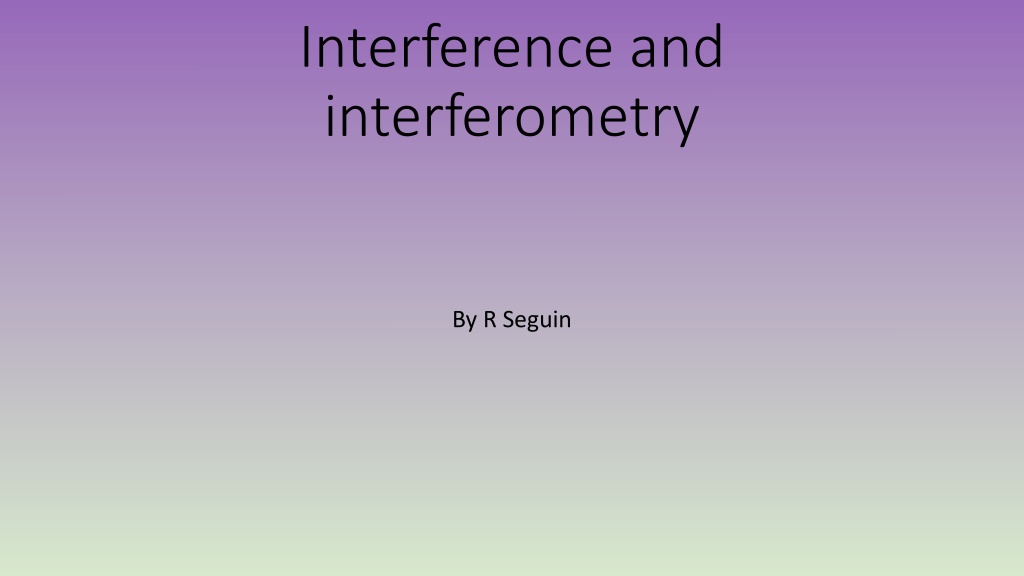Exploring Light Interference and Interferometry
Discover the fascinating world of light interference and interferometry through examples like Young's double slit experiment and supernumerary rainbows. Understand how the path length difference affects interference levels and delve into the applications of interferometry across various scientific fields. Uncover the principles and formulas behind interference phenomena, from thin film interference to the double slit experiment.
Download Presentation

Please find below an Image/Link to download the presentation.
The content on the website is provided AS IS for your information and personal use only. It may not be sold, licensed, or shared on other websites without obtaining consent from the author. Download presentation by click this link. If you encounter any issues during the download, it is possible that the publisher has removed the file from their server.
E N D
Presentation Transcript
Interference and interferometry By R Seguin
What is light interference? Remember sound interference? Its like that but with light. Simple as that. the Path Length Difference equals some number multiplied by the wavelength and we have different levels of interference depending on what that number is PLD = m When two waves of light converge they can cause the light we see to change just like how sound interference changes the sound we hear Its often caused by diffraction
Examples of interference Young s double slit experiment Supernumerary rainbows Those rainbow colors formed by oil on water or soap bubbles
Double slit experiment The double slit experiment is a very classic way to view interference of light But is easier to do in theory than experimentally since the distance between the slits has to be very small
Those other things I mentioned Supernumerary rainbows are the lighter rainbows inside the main rainbow created by the interference of the light coming out oat different angles from the water droplets. Thin film interference is formed by some of the light reflecting off of the top of the film while other light reflects off the surface under the film thus creating a difference in the distance traveled by the two waves putting them out of phase.
general rule: PLD = mwe have complete constructive interference when m = n = {0,1,2,3} we will have perfect destructive interference when m = n + 0.5 Math Thin film: 2n2dcos 2 = m using Snell's law we can use n1sin( 1) = n2sin( 2) to find 2 Double slit formula: dsin = m this only holds if d and a are both very small distance and D is much much larger than both
What is interferometry? Interferometry is a general term for sciences that use the interference of electromagnetic waves to collect data. Interferometry is quite wide reaching with uses in fields from astronomy to medicine. Because the maximum interference values happen every time the path length difference is half a wavelength and the wavelength of light is very small we can make very precise readings but these devises are easily disturbed by any nearby vibrations. Diagram of an interfferometer
Gravitational waves First hypothesized by albert Einstein (although we don t know how much work was done by his first wife Mileva Maric) in 1916 in the general theory of relativity. Essentially they are ripples in space-time created by dramatic changes in how n object is affecting spacetime like a supernova collapsing into a black hole or a massive object with a huge acceleration moving towards another massive object. These waves are some of the weakest forces in the universe needing one of the most sensitive of measuring devices ever created to observe even the most powerful of GWs
Laser Interferometer Gravitational-Wave Observatory The observatory consists of two massive interferometers. One located in Hanford Washington and one in Livingston Louisiana. The reason they are so far apart is so local vibrations can be ruled out while looking for the same interference at the same time from both locations, then that data is sent to other observatories to see if they got similar results. Each arm of these interferometers are 4km long On September 14 2015 LIGO observed actual physical affects of gravitational waves for the first time Thee waves were caused by two black holes colliding but by the time they reached earth they only moved space-time an less than the diameter of a proton.
Holographic interferometry This type of interferometry involves the superposition of holograms of a object that is being studied. Any movement of the object causes interference this movement can be caused by vibration, heating, stress, etc. analyzing this interference can give information about the object
Sample test question Light of wavelength 510nm is traveling at a thin film of oil on top of water at an angle of 60 above the horizontal. the refractive index of air is 1.00 and the index of oil is 1.46. what is the first 3 thicknesses d of the film of oil for which we would have complete destructive interference?
Bibliography "Double Slit Interference." Slit Interference. Hyperphysics, n.d. Web. 30 May 2017. <http://hyperphysics.phy-astr.gsu.edu/hbase/phyopt/slits.html>. Hariharan, P. Basics of Interferometry. Amsterdam: Elsevier, 2007. Print. "holographic interferometry." The Penguin Dictionary of Physics, edited by John Cullerne, Penguin, 4th edition, 2009. Credo Reference, http://www.student.wvc.edu:2548/content/entry/pendphys/holographic_interferometry/0. Accessed 30 May 2017. "Learn More." LIGO Lab. Caltech and MIT, n.d. Web. 30 May 2017. <https://www.ligo.caltech.edu/page/learn-more>. "Oil Film Interference." Thin Film Reflection and Interference. Hyperphysics, n.d. Web. 30 May 2017. <http://hyperphysics.phy-astr.gsu.edu/hbase/phyopt/oilfilm.html>. Serway, Raymond, and John Jewett. "Interference of Light Waves." Physics for Scientists and Engineers. 7th ed. N.p.: Cengage Learning, 2007. 1051-099. Print. Wolf, Emil, and Max Born. Principles of Optics: Electromagnetic Theory of Propagation, Interference and Diffraction of Light. Oxford: Pergamon, 1970. Print. Young's Double Slit Introduction. Dir. David SantoPietro. Khan Acadeny. Youtube, 07 July 2014. Web. 29 May 2017. <https://www.khanacademy.org/science/physics/light- waves/interference-of-light-waves/v/youngs-double-split-part-1>.


























